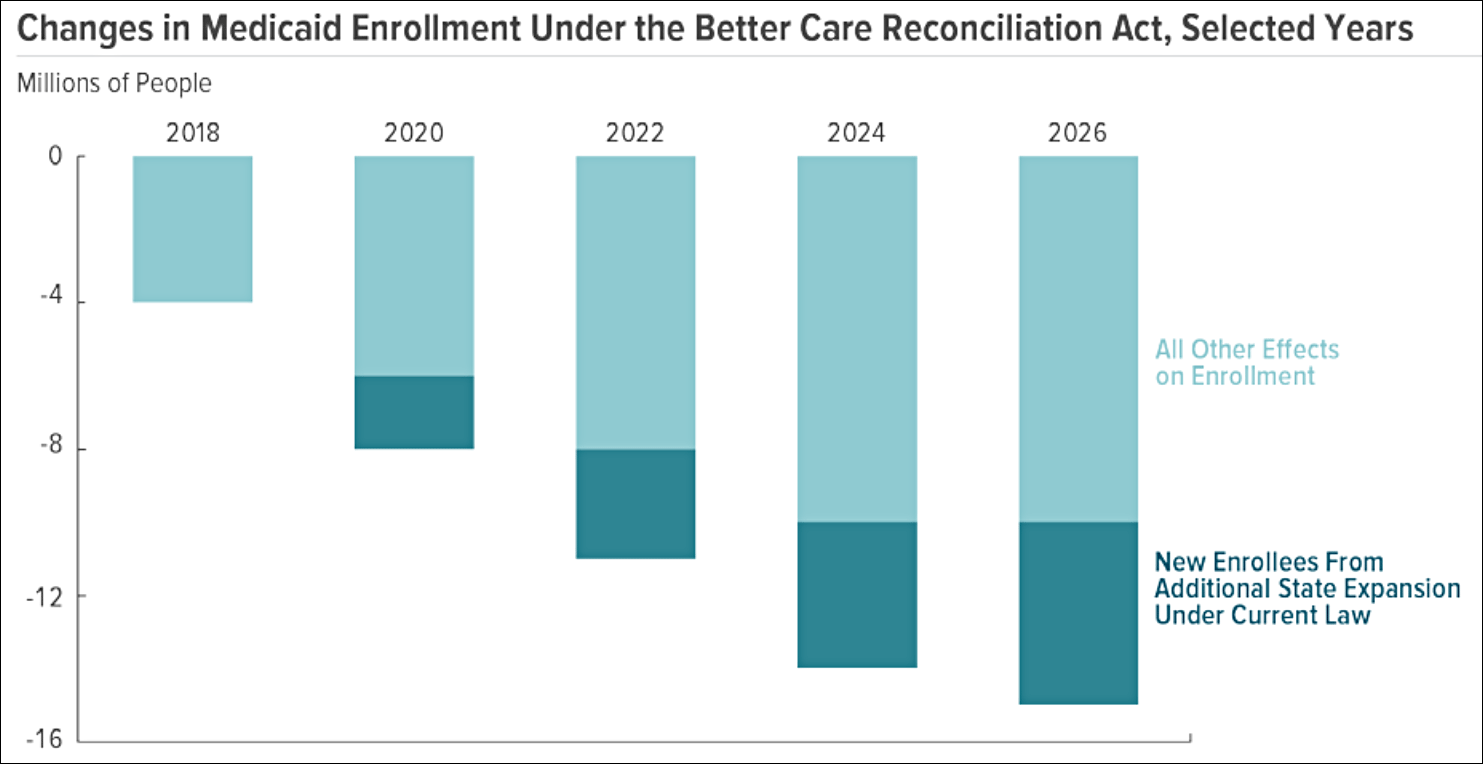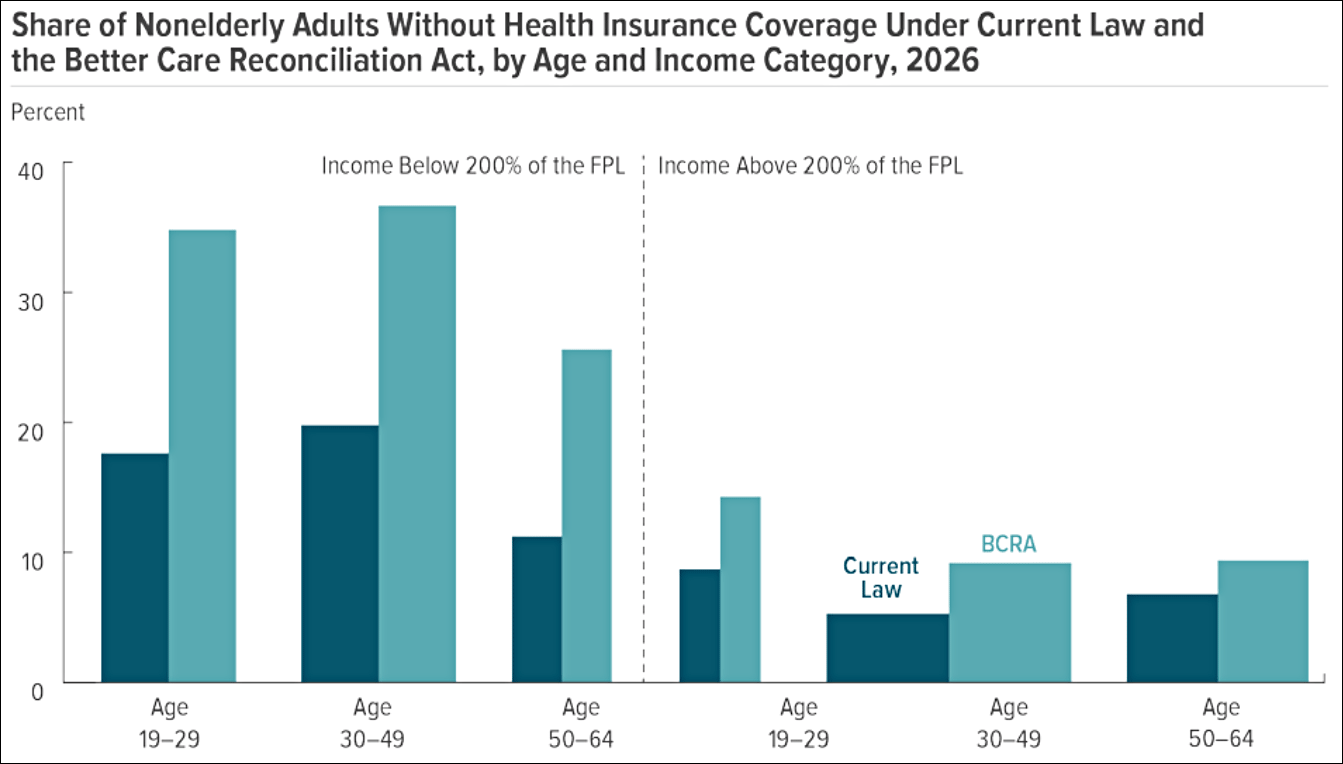The CBO’s score of the Senate heath care bill is out. There are no surprises: it contains big tax cuts for the rich and big health care cuts for the poor. But let’s go through the dreary details anyway:
- By 2026, spending on Medicaid will be slashed $772 billion. (Page 5)
- As a result, there will be 15 million fewer people on Medicaid. (Page 16)
- By 2026, spending on subsidies for private insurance will be slashed $408 billion. (Page 5)
- As a result, there will be 7 million fewer people with private insurance. (Page 17)
- This sums to a total of 22 million more uninsured people by 2026, compared to 23 million under the House version of the bill.

- Revenue would be reduced about $750 billion, mostly via tax cuts on corporations and the wealthy. (Tables 2 and 3)
- Obamacare is not in a death spiral: “The subsidies to purchase coverage, combined with the effects of the individual mandate…are anticipated to cause sufficient demand for the market to be stable in most areas.” (Page 6)
- BCRA would also be stable. However: “A small fraction of the population resides in areas in which—because of this legislation, at least for some of the years after 2019—no insurers would participate in the nongroup market or insurance would be offered only with very high premiums. Some sparsely populated areas might have no nongroup insurance offered….In addition, the agencies anticipate that all insurance in the nongroup market would become very expensive for at least a short period of time for a small fraction of the population residing in areas in which states’ implementation of waivers with major changes caused market disruption.” (Page 7)
- Deductibles for silver plans will increase from about $3,600 to about $6,000. (Page 8)
- The actuarial value of health care plans will be reduced to 58 percent. This means that even after buying insurance, consumers are responsible for 42 percent of their total health care expenses. “As a result, despite being eligible for premium tax credits, few low-income people would purchase any plan.” (Page 8)
- “Because nongroup insurance would pay for a smaller average share of benefits under this legislation, most people purchasing it would have higher out-of-pocket spending on health care than under current law.” (Page 9)
- Because of the reduced value of health care policies under BCRA, premiums will go down. (Page 9) However, net premiums after accounting for subsidies will go up for most people. Among those with modest incomes, net premiums for silver plans would go up $500 for 21-year-olds; $1,300 for 40-year-olds; and $4,800 for 64-year-olds. Among those with higher incomes, net premiums would go down except for 64-year-olds, who would face increases as high as $13,000. (Table 5)
- The share of uninsured older folks with low incomes would skyrocket from about 11 percent to 26 percent. (Page 16)

- Caps on Medicaid spending will likely cause some states to reduce already low reimbursement rates for doctors. If this happens, “fewer providers might be willing to accept Medicaid patients….If states reduced payments to Medicaid’s managed care plans, some plans might shrink their provider networks, curtail quality assurance, or drop out of the managed care program altogether.” (Page 30)
Reading the CBO report in its entirety, it’s hard to see that BCRA offers any improvements over Obamacare aside from cutting taxes for the rich. Net premiums go up for most people—quite massively in the case of older consumers; deductibles go up; out-of-pocket expenses go up; the working poor are virtually shut out of the insurance market; the quality of coverage gets worse; and 22 million people lose insurance.
The only plausible path for any improvement is the increased flexibility states would have to run their own health care progams. Historically, this has accomplished little except to allow conservative states to cut back on health services to the poor, so you’d need to be mighty starry-eyed to think that it will produce amazing innovations this time around. But that’s about it: believing in the power of states to innovate because they have less money is the only path for defenders of BCRA.

















